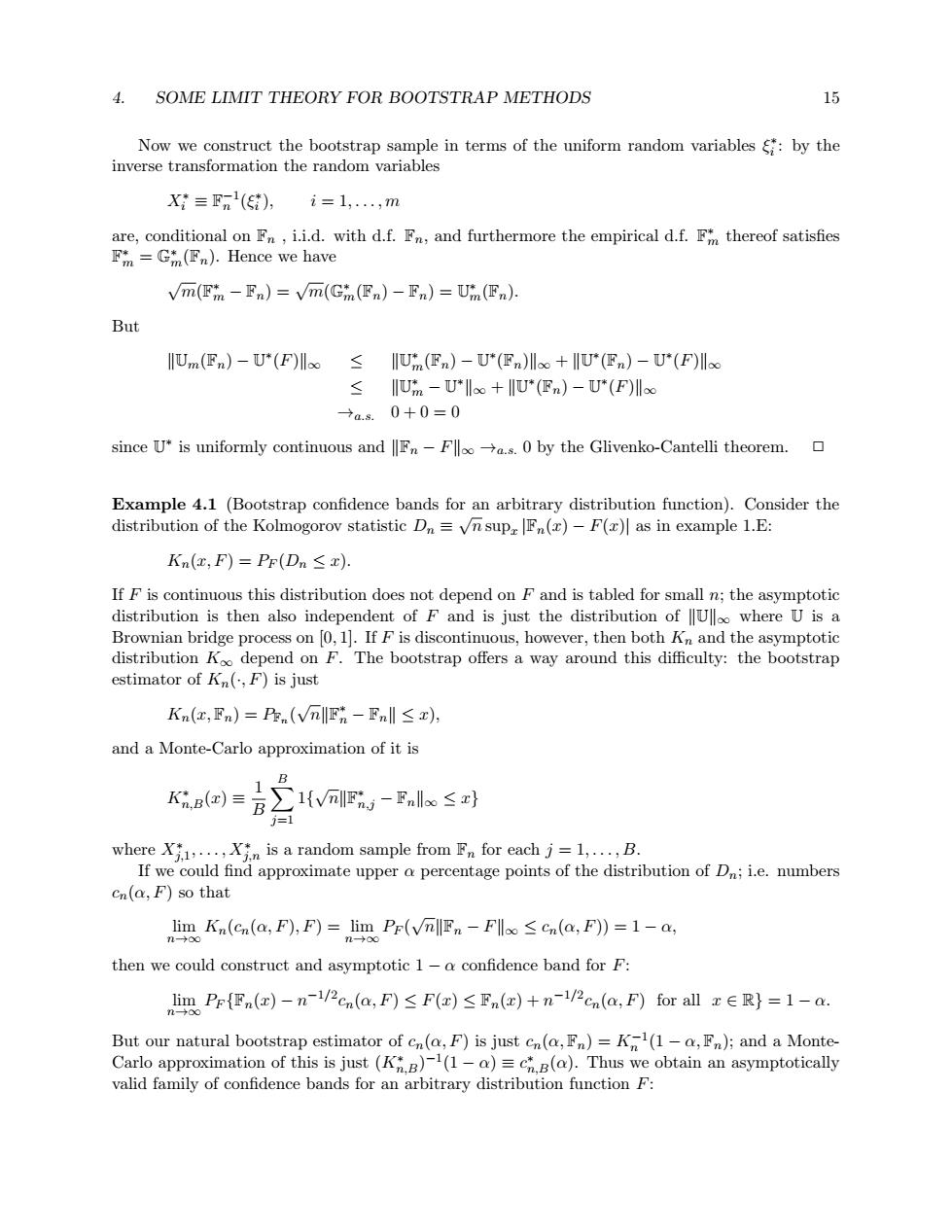正在加载图片...

4.SOME LIMIT THEORY FOR BOOTSTRAP METHODS 15 Now we construct the bootstrap sample in terms of the uniform random variables by the inverse transformation the random variables X≡Fn(), i=1,.,m are,conditional on Fn,i.i.d.with d.f.Fn,and furthermore the empirical d.f.Fm thereof satisfies Fi=Gm(Fn).Hence we have Vm(Fm-Fn)=Vm(Gm(Fn)-Fn)=Um(Fn). But llUm(Fn)-U*(F)Iloo lUm (Fn)-U*(Fn)Iloo +lU*(F)-U*(F)Iloc ≤IUm-Ul✉+IU(Fn)-U*(F)∞ →a.s.0+0=0 since U*is uniformly continuous and Fn-Flloo-a.s.0 by the Glivenko-Cantelli theorem. Example 4.1 (Bootstrap confidence bands for an arbitrary distribution function).Consider the distribution of the Kolmogorov statistic Dn=vn sup Fn(x)-F(x)as in example 1.E: Kn(x,F)=Pr(Dn≤x) If F is continuous this distribution does not depend on F and is tabled for small n;the asymptotic distribution is then also independent of F and is just the distribution of Uloo where U is a Brownian bridge process on 0,1].If F is discontinuous,however,then both Kn and the asymptotic distribution Koo depend on F.The bootstrap offers a way around this difficulty:the bootstrap estimator of Kn(,F)is just Kn(I,Fn)=Pen(VnlFn-Fnll t), and a Monte-Carlo approximation of it is B KB网=a1vg-≤ 7=1 where X,...,Xi is a random sample from Fn for each j=1,...,B. If we could find approximate upper a percentage points of the distribution of Dn;i.e.numbers cn(a,F)so that lim Kn(cn(a,F),F)=lim PF(vnlFn-Flloo cn(a,F))=1-a, then we could construct and asymptotic 1-a confidence band for F: lim PrfFn()-n-1/2en(a,F)<F()<Fn()+n-1/2cn(a,F)for all ER}=1-a. →c But our natural bootstrap estimator of cn(a,F)is just cn(a,Fn)=K(1-a,Fn);and a Monte- Carlo approximation of this is just (K)1(1-a)=c(a).Thus we obtain an asymptotically valid family of confidence bands for an arbitrary distribution function F:4. SOME LIMIT THEORY FOR BOOTSTRAP METHODS 15 Now we construct the bootstrap sample in terms of the uniform random variables ξ ∗ i : by the inverse transformation the random variables X∗ i ≡ F −1 n (ξ ∗ i ), i = 1, . . . , m are, conditional on Fn , i.i.d. with d.f. Fn, and furthermore the empirical d.f. F ∗ m thereof satisfies F ∗ m = G∗ m(Fn). Hence we have √ m(F ∗ m − Fn) = √ m(G ∗ m(Fn) − Fn) = U ∗ m(Fn). But kUm(Fn) − U ∗ (F)k∞ ≤ kU ∗ m(Fn) − U ∗ (Fn)k∞ + kU ∗ (Fn) − U ∗ (F)k∞ ≤ kU ∗ m − U ∗ k∞ + kU ∗ (Fn) − U ∗ (F)k∞ →a.s. 0 + 0 = 0 since U ∗ is uniformly continuous and kFn − Fk∞ →a.s. 0 by the Glivenko-Cantelli theorem. ✷ Example 4.1 (Bootstrap confidence bands for an arbitrary distribution function). Consider the distribution of the Kolmogorov statistic Dn ≡ √ n supx |Fn(x) − F(x)| as in example 1.E: Kn(x, F) = PF (Dn ≤ x). If F is continuous this distribution does not depend on F and is tabled for small n; the asymptotic distribution is then also independent of F and is just the distribution of kUk∞ where U is a Brownian bridge process on [0, 1]. If F is discontinuous, however, then both Kn and the asymptotic distribution K∞ depend on F. The bootstrap offers a way around this difficulty: the bootstrap estimator of Kn(·, F) is just Kn(x, Fn) = PFn ( √ nkF ∗ n − Fnk ≤ x), and a Monte-Carlo approximation of it is K∗ n,B(x) ≡ 1 B X B j=1 1{ √ nkF ∗ n,j − Fnk∞ ≤ x} where X∗ j,1 , . . . , X∗ j,n is a random sample from Fn for each j = 1, . . . , B. If we could find approximate upper α percentage points of the distribution of Dn; i.e. numbers cn(α, F) so that limn→∞ Kn(cn(α, F), F) = limn→∞ PF ( √ nkFn − Fk∞ ≤ cn(α, F)) = 1 − α, then we could construct and asymptotic 1 − α confidence band for F: limn→∞ PF {Fn(x) − n −1/2 cn(α, F) ≤ F(x) ≤ Fn(x) + n −1/2 cn(α, F) for all x ∈ R} = 1 − α. But our natural bootstrap estimator of cn(α, F) is just cn(α, Fn) = K−1 n (1 − α, Fn); and a MonteCarlo approximation of this is just (K∗ n,B) −1 (1 − α) ≡ c ∗ n,B(α). Thus we obtain an asymptotically valid family of confidence bands for an arbitrary distribution function F: